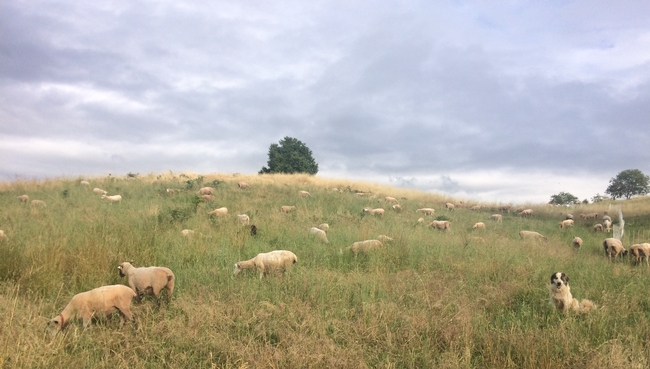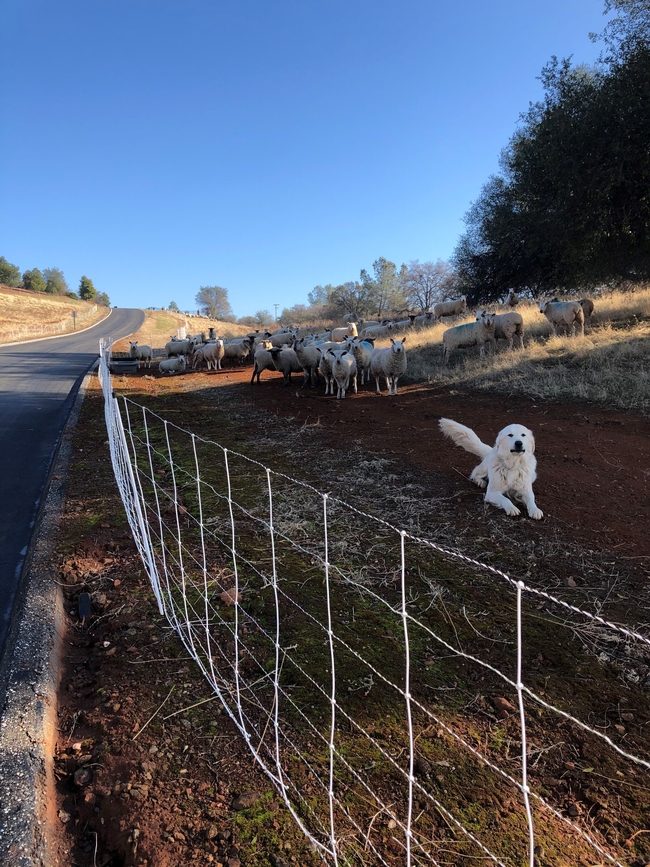When it comes to livestock protection tools, there are no "silver bullets"....

I want to start this blog post by saying I'm convinced that livestock guardian dogs (LGDs), if properly bred and bonded, are the most effective livestock protection tool available to me as a small-scale commercial sheep producer. I have game camera photos of coyotes, bobcats, foxes, and even mountain lions within 50 yards of our lambing paddocks that prove to me that our dogs are working. I have lost replacement ewes to coyotes in each of the last two years where we were unable to have a dog with our sheep. But like every nonlethal tool in my tool box, LGDs are not a silver bullet. They aren't perfect, and I was reminded of this today.
I've written frequently about our bonding process - about the importance of bonding a young pup with OUR livestock and our management system. Over the 17 years that we've raised sheep and used dogs, I've become better at managing this process. I select pups from working parents - pups that are born where they can hear and smell sheep before their eyes are open. I put pups with dry ewes as soon as I can (preferably at 8-10 weeks of age). I put teenage dogs with rams to cure their desire to play and roughhouse. And I put young dogs (at 18-24 months) with an older dog at lambing as part of their final exam - an older dog will often enforce respect for the lambing process and ensure that a younger dog doesn't interfere (or worse, steal or kill a lamb).
But every dog is different. Just as every border collie pup out of working parents doesn't necessarily make a sheep dog, every LGD pup doesn't make a trustworthy guardian.
I bought Dillon several years ago at an auction - he was a promising pup from a sheep outfit in northern Nevada. We bonded him as we bond all of our LGDs - and he made expected progress - for the most part. Dillon has been slow to mature behaviorally. Most dogs, at two-and-a-half years of age, are mature (mentally and physically). Dillon still acts like a pup sometimes. He's overly exuberant at feeding time. He bounds up to sheep playfully. He's a goofball.
And today, we think, he's a lamb thief.
For a variety of reasons, we have a small group of very late lambing yearling ewes this year - which is not our normal practice. Last week, we sorted off the ewes we thought were pregnant and kept them at home after we sheared the flock last weekend. Dillon, who had been with our rams, was turned out with the older pairs (and with an older dog) - we kept the pregnant ewes at home, with an older dog. Unfortunately, we missed one of the pregnant yearlings, and she remained with the main flock.
This morning, when my partner checked the main flock, he found Dillon with a newborn lamb in his mouth. Dead. The ewe was a maiden; an experienced ewe might have chased Dillon off. Unfortunately, this first-time mother did not - nor did the older dog. Now we're faced with a dilemma - we have a dog that's great with older pairs, dry ewes, or rams, but who wants to keep new lambs “safe” from their mothers.
Ultimately, I think, this comes down to selecting the right dog for the job - or maybe it's the right job for the dog. We currently have two outstanding lambing dogs - dogs who are entirely trustworthy with lambing ewes. We have a third dog, Dillon, who is effective in less complicated situations. How do we manage this going forward?
Every dog is different - just as every operation is different. Dillon is great with our rams. He's great with dry ewes or older pairs. He's not, unfortunately, a suitable replacement for our older lambing dogs. He's not a perfect dog - he's no silver bullet. The same can be said of any livestock protection too, ultimately.
